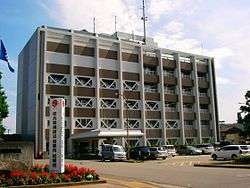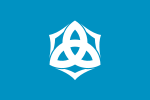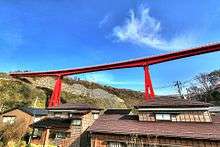Kashiwazaki, Niigata
Kashiwazaki (柏崎市, Kashiwazaki-shi) is a city located in Niigata Prefecture, Japan. As of July 1, 2019, the city had an estimated population of 82,788 in 34,839 households,[1] and a population density of 187 persons per km². The total area of the city was 442.03 square kilometres (170.67 sq mi).
Kashiwazaki 柏崎市 | |
|---|---|
 Kashiwazaki City Hall | |
 Flag Seal | |
 Location of Kashiwazaki in Niigata | |
 Kashiwazaki | |
| Coordinates: 37°22′18.9″N 138°33′32.4″E | |
| Country | Japan |
| Region | Chūbu (Kōshin'etsu) (Hokuriku) |
| Prefecture | NIigata |
| Government | |
| • Mayor | Masahiro Sakurai |
| Area | |
| • Total | 442.03 km2 (170.67 sq mi) |
| Population (July 1, 2019) | |
| • Total | 82,788 |
| • Density | 190/km2 (490/sq mi) |
| Time zone | UTC+9 (Japan Standard Time) |
| Symbols | |
| • Tree | Sakura |
| • Flower | Lilium auratum |
| • Bird | Swan |
| Phone number | 0257-23-5111 |
| Address | 5-50, Chūōchō, Kashiwazaki-shi, Niigata-ken 945-8511 |
| Website | Official website |
Geography
Kashiwazaki is located in a coastal region of south-central Niigata Prefecture. Part of the city is within the borders of the Sado-Yahiko-Yoneyama Quasi-National Park. The highest elevation is the summit of Mount Gozu at 912 meters.
Surrounding municipalities
Climate
Kashiwazaki has a Humid climate (Köppen Cfa) characterized by warm, wet summers and cold winters with heavy snowfall. The average annual temperature in Kashiwazaki is 13.0 °C. The average annual rainfall is 2360 mm with September as the wettest month. The temperatures are highest on average in August, at around 26.0 °C, and lowest in January, at around 1.4 °C.[2]
Demographics
Per Japanese census data,[3] the population of Kashiwazaki peaked at around the year 1995, and has declined steadily since.
| Census Year | Population |
|---|---|
| 1970 | 94,990 |
| 1980 | 95,892 |
| 1990 | 99,265 |
| 2000 | 97,896 |
| 2010 | 91,451 |
History
The area of present-day Kashiwazaki was part of ancient Echigo Province and developed as a post station on the Hokuriku-dō highway. Under the Tokugawa shogunate of Edo period Japan, parts of what is now Kashiwazaki were under the control of Shiiya Domain, a minor fudai feudal domain ruled by a junior branch of the Hori clan,[4] while other parts were tenryō territory under direct control of the shogunate, or were exclaves of Kuwana Domain (Ise Province), Kaminoyama Domain (Mutsu Province), Nagaoka Domain (Echigo Province) or Yoita Domain (Echigo Province). Pre-modern Kashiwazaki was located within the holdings of Kuwana Domain. The modern town of Kashiwazaki was established on April 1, 1889, within Kariwa District, Niigata with the establishment of the municipalities system. During the Meiji period, the discovery of petroleum in the area led to an economic boom and increase in population. Kashiwazaki was elevated to city status on 1 July 1940. (It was the fifth city created within Niigata Prefecture).
On November 1, 1968, Kashiwaza absorbed the village of Kurohime, followed by the town of Kitajō on May 1, 1971 (both from Kariwa District). The city annexed part of the town of Kakizaki (from Nakakubiki District) on April 1, 1989 and the towns of Nishiyama and Takayanagi (both from Kariwa District) on May 1, 2005.
2007 earthquake
On July 16, 2007, a magnitude 6.8 earthquake hit off the coast of Kashiwazaki, killing 11 people,[5] and injuring more than 700, causing massive power outages, a tsunami warning, and other disasters. The quake forced the Kashiwazaki-Kariwa Nuclear Power Plant to shut down for 10 months as of May 2008.[6][7]
Government
Kashiwazaki has a mayor-council form of government with a directly elected mayor and a unicameral city legislature of 26 members. The city contributes two members to the Niigata Prefectural Assembly.
Economy and Industries
Kashiwazaki has traditionally been a center for commercial fishing, machinery, glassware and lumber processing. The city is home to the Kashiwazaki-Kariwa nuclear power plant, the largest nuclear generating station in the world by net electrical power rating.
Bourbon, a major confectionery company in Japan, is headquartered in Kashiwazaki.[8]
Education
Colleges and universities
Primary and secondary education
Kashiwazaki has 28 public elementary schools and 12 public middle schools operated by the city. There are four public high schools operated by the Niigata Prefectural Board of Education, and one private high school. The prefecture also operates two special education schools.
Transportation

Railway
![]()
- Yoneyama - Kasashima - Ōmigawa - Kujiranami - Kashiwazaki - Ibarame - Yasuda - Kitajō - Echigo-Hirota - Nagatori
![]()
- Kashiwazaki - Higashi-Kashiwazaki - Nishi-Nakadōri - Arahama - Kariwa - Nishiyama - Raihai - Ishiji
Highway
.png)







Sister city relations

Local attractions
- Shimoyachi Site, a National Historic Site.
- Kashiwazaki is host to many cultural events every year, including the Kaze no Jin festival in May, En Ma Ichi in June, DonGALA in July, and Gion, also in July.
Notable people from Kashiwazaki
- Akiko Yajima, voice actress
- Chinami Nishimura, voice actress
- Daisuke Sakaguchi, voice actor
- Hiroki Yagami, manga artist
- Ikue Ōtani, actress
- Ikuo Hirayama, former governor of Niigata Prefecture
- Makiko Tanaka, politician
- Kakuei Tanaka, politician and the 64th and 65th Prime Minister of Japan
- Makoto Ogawa, singer (former member of Morning Musume)
- Mihiro, singer and actress
- Motoei Shinzawa, manga artist
- Tsunesaburo Makiguchi, first president of Sōka Gakkai
References
- 住民基本台帳人口・世帯数 [Basic resident register population, number of households]. Kashiwazaki Municipal Government (in Japanese). March 11, 2019. Retrieved March 14, 2019.
- "Kashiwazaki climate: Average Temperature, weather by month, Kashiwazaki weather averages". Climate-Data.org. Retrieved March 14, 2019.
- "Kashiwazaki population statistics". citypopulation.de. Retrieved March 14, 2019.
- 椎谷藩 [Shiiya Clan]. asahi-net.or.jp (in Japanese). Retrieved March 14, 2019.
- Alex K. Tang, PE and Anshel J. Schiff, ed. (2007). Kashiwazaki, Japan Earthquake of July 16, 2007. Reston, VA: ASCE, Technical Council on Lifeline Earthquake Engineering. ISBN 9780784410622. Archived from the original on September 28, 2013. Retrieved July 13, 2012.
- Kwok, Vivian Wai-yin (July 17, 2007). "Japanese Stocks Hit By Aftershocks Of Quake". Forbes. Archived from the original on June 9, 2008. Retrieved March 14, 2019.
- McErlain, Eric (July 17, 2007). "More on the Japan Quake and the Kashiwazaki-Kariwa Nuclear Plant". NEI Nuclear Notes. Nuclear Energy Institute. Retrieved March 14, 2019.
- "BOURBON: Company Profile: Manufacturing Quality Headquarters". Bourbon Corporation Japan. Archived from the original on December 22, 2015. Retrieved March 14, 2019.
- "International Exchange". List of Affiliation Partners within Prefectures. Council of Local Authorities for International Relations (CLAIR). Archived from the original on March 10, 2016. Retrieved July 1, 2016.
External links
| Wikimedia Commons has media related to Kashiwazaki, Niigata. |
- Official Website (in Japanese)